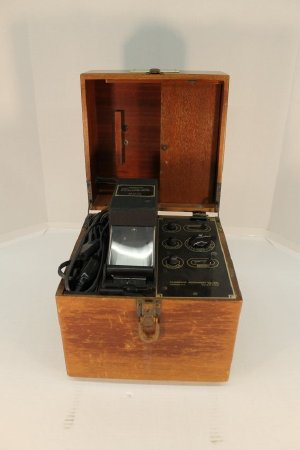Object ID Number:
EH102102
Object Name:
Electrocardiograph Machine
Type:
"Simpli–Scribe" Portable Model Electroca
Manufacturer:
Cambridge Instrument Co., Inc. Ossining, N.Y
Manufactured from:
1945
Manufactured to:
1960
Description / History:
This EKG machine, also known as the "Simpli–Scribe" Portable Model, is complete with a canvas cover with leather on the sides and a wooden case with a metal clasp. Inside includes cords to plug into machine, wooden door that slides left and right as storage, plastic dials for "Sensitivity" "Position" "Leads" "Heat", and levers for "Record" and "Standardize." The machine uses paper to record the electric currents. On the top contains a label stating: "'Simpli–Scribe' Portable Model; Cambridge Electrocardiograph; NO. 0–213248; Made for COLUMBIA HOSPITAL; Columbia, Penna; by the CAMBRIDGE INSTRUMENT CO, INC. Inside the case also contains two more labels stating Cambridge Instrument Co., Inc.; Ossining, N.Y.; No. B.M. 17850. Although none of the numbers on the machine trace directly to any dates, an add in the Journal of the American Heart Association in Aug 1950 for the "Simpli–Scribe" model by Cambridge indicate that these were manufactured around the time period of the 1950s.
Dimensions:
H–11 W–10.25 L–10.25 inches
Additional Information:
Electrocardiograms (EKGs)
An electrocardiogram (also called ECG or EKG) is a noninvasive test that records the electrical activity of the heart. This examination is useful because, with each heartbeat, an electrical signal spreads from the top to the bottom of the heart. As this electrical signal travels, it induces the heart to contract, and to pump blood throughout the body. Since the heart's electrical signals determine the rhythm of the heartbeat, an EKG can be used to show how quickly the heart is beating, whether the heart's rhythm is steady or irregular, and how strongly the electrical signals pass through each part of the heart. Based on these readings, a physician may discover a number of conditions, such as arrhythmias or recent heart attacks, and may also monitor the functioning of implanted pacemakers.
The earliest electrocardiogram was designed in 1901 by William Einthoven, a scientist from the Netherlands. In Einthoven's design, currents from the heart's electrical signals were carried down a silver coated glass conducting wire which was suspended between two electromagnets. The fluctuations of the wire as a result of the changing electrical currents were transcribed onto a photographic plate and produced readouts similar to those given by modern EKGs (although Einthoven's machine weighed 600 pounds, took up two rooms, and needed five people to operate).
EKGs remain one of the most important diagnostic tools today, and in 2011, 82,707 EKGs were performed at Lancaster General Hospital (or affiliated healthcare institutions), which amounts to a staggering 226 per day.
An electrocardiogram (also called ECG or EKG) is a noninvasive test that records the electrical activity of the heart. This examination is useful because, with each heartbeat, an electrical signal spreads from the top to the bottom of the heart. As this electrical signal travels, it induces the heart to contract, and to pump blood throughout the body. Since the heart's electrical signals determine the rhythm of the heartbeat, an EKG can be used to show how quickly the heart is beating, whether the heart's rhythm is steady or irregular, and how strongly the electrical signals pass through each part of the heart. Based on these readings, a physician may discover a number of conditions, such as arrhythmias or recent heart attacks, and may also monitor the functioning of implanted pacemakers.
The earliest electrocardiogram was designed in 1901 by William Einthoven, a scientist from the Netherlands. In Einthoven's design, currents from the heart's electrical signals were carried down a silver coated glass conducting wire which was suspended between two electromagnets. The fluctuations of the wire as a result of the changing electrical currents were transcribed onto a photographic plate and produced readouts similar to those given by modern EKGs (although Einthoven's machine weighed 600 pounds, took up two rooms, and needed five people to operate).
EKGs remain one of the most important diagnostic tools today, and in 2011, 82,707 EKGs were performed at Lancaster General Hospital (or affiliated healthcare institutions), which amounts to a staggering 226 per day.
